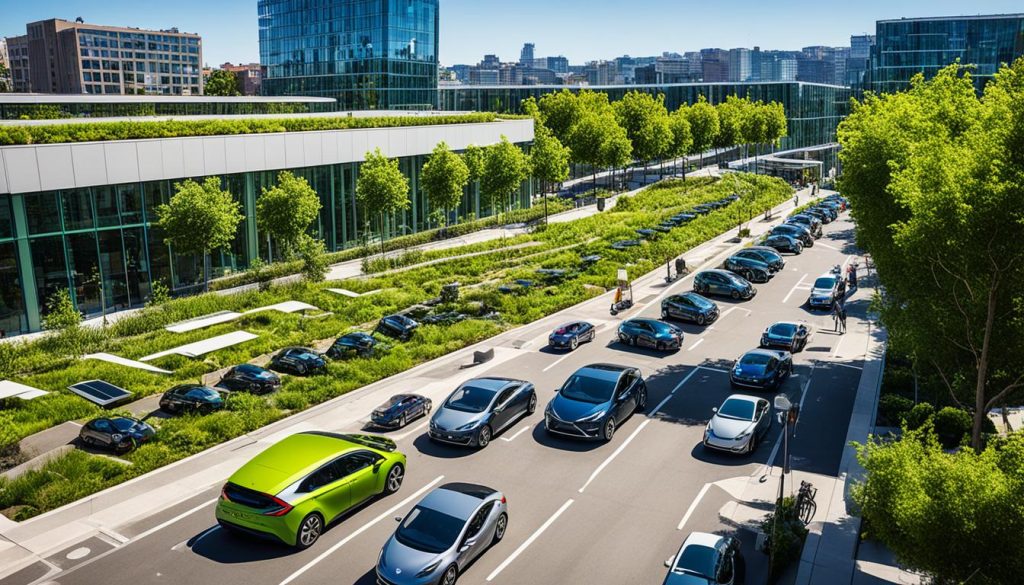Greening the Roads to Innovations in Eco Friendly Vehicle Technology for Sustainable Transportation
In today’s rapidly evolving world, transportation infrastructure plays a crucial role in our lives. However, it is essential to assess the environmental impacts of these projects before proceeding, considering the growing concerns about climate change and sustainability. Conducting comprehensive environmental impact evaluations helps understand the potential adverse effects of these projects and allows for mitigation and minimization of their impact on the environment.
Environmental impact evaluation provides crucial insights and data that empower policymakers, engineers, and project managers to make sustainable decisions. It also helps protect local ecosystems, reduce carbon footprint, and enhance public health. The evaluation process includes scoping, baseline assessment, impact prediction, mitigation and management, and monitoring and post-construction assessment. By improving evaluations, embracing technology, and engaging stakeholders, transportation infrastructure projects can align with environmental goals and contribute to a more sustainable planet.
Key Takeaways:
- Evaluating the environmental impact of transportation projects is crucial for sustainability
- Comprehensive impact evaluations enable mitigation and minimization of adverse effects
- Environmental evaluations empower decision-makers to make sustainable choices
- Improving evaluations, embracing technology, and engaging stakeholders is essential for sustainable transportation
- Transportation infrastructure can align with environmental goals for a greener future
Assessing the Ecological Footprint: Analyzing Environmental Impact of Transportation Projects
Transportation methods have a significant impact on the environment, contributing to pollution, climate change, and ecological degradation. Analyzing the ecological footprint of transportation projects is crucial for understanding their environmental impact. This assessment involves evaluating factors such as emissions and air quality, energy efficiency, noise pollution, and land use.
By conducting comprehensive assessments, we can identify areas to improve sustainability, reduce emissions, and minimize our carbon footprint. Assessing the ecological footprint and addressing environmental impacts can lead to pollution reduction, the promotion of sustainable transportation options, and the creation of energy-efficient transportation systems. By protecting natural habitats and biodiversity, we can foster sustainable urban development and create a greener future for our transportation systems.
The Environmental Impact Assessment Process
“The environmental impact assessment process provides a framework for evaluating the potential consequences of transportation projects on the environment and helps guide decision-making towards sustainable solutions.”
In order to assess the ecological footprint and environmental impact of transportation projects, a rigorous evaluation process must be followed. This process typically includes the following steps:
- Scoping: Identifying the key environmental issues and stakeholders involved in the project.
- Baseline Assessment: Gathering data on the current environmental conditions in the project area.
- Impact Prediction: Analyzing the potential environmental effects of the project.
- Mitigation and Management: Developing strategies to minimize and mitigate the negative impacts.
- Monitoring and Post-Construction Assessment: Continuously monitoring the project’s environmental performance and assessing its long-term effects.
By implementing this comprehensive assessment process, we can ensure that transportation projects are developed in an environmentally responsible manner. This not only helps reduce the ecological footprint but also contributes to a more sustainable and livable future.
Smart Traffic Signals: Greening Our Cities
Smart Traffic Signals play a transformative role in reducing carbon footprints and shaping the future of eco-friendly urban transportation. These intelligent systems optimize traffic flow, prioritize green modes of transport, synchronize signals to create “green waves,” and reduce congestion. They also integrate with electric vehicle charging management, making it easier for electric vehicle owners to charge during off-peak hours when clean energy sources are more abundant.

Smart Traffic Signals generate valuable data for informed decision-making, infrastructure development, and sustainability efforts. However, challenges such as data privacy and security, infrastructure development, and public awareness and adoption need to be addressed. By leveraging the potential of Smart Traffic Signals and overcoming these challenges, we can create sustainable and eco-friendly urban landscapes.
Towards Environmentally Sustainable Transport Systems and Services
The rise in trade and population growth in Asia and the Pacific has significantly increased the demand for passenger mobility and freight transport services. However, the intensity of transport activities, particularly road transport, has resulted in the transport sector becoming a leading emitter of greenhouse gases and pollution, as well as a major consumer of fossil fuels. To achieve the Sustainable Development Goals, the region must accelerate low carbon transport actions.
This includes decarbonizing the regional supply chain and promoting low carbon mobility. By transitioning to sustainable transport systems and services, the region can reduce its carbon footprint, decrease air pollution, and foster a greener future. Implementing innovative technologies and adopting clean energy sources are essential steps towards achieving these goals.
The lessons learned from the COVID-19 pandemic have shown the importance of resilient and adaptable transport systems. The pandemic has accelerated the adoption of technology-enabled solutions and highlighted the potential for remote work and virtual meetings, reducing the need for daily commuting. These lessons can inform the development of environmentally sustainable mobility in the future.
To drive the transition towards low carbon transport communities, policymakers, governments, and stakeholders must collaborate and implement targeted policies, strategies, and programs. The policy directions, actions, and activities described in this document, along with the regional action program for sustainable transport development, provide a roadmap for achieving environmentally sustainable transport systems and services.
By prioritizing sustainable transport, low carbon solutions, and mobility innovations, the Asia-Pacific region can lead the way towards a greener and more sustainable future. Together, we can create a world where transportation supports economic growth, enhances quality of life, and preserves the environment for generations to come.

Asia-Pacific Region: Status and Challenges
The Asia-Pacific region is facing significant challenges due to the rising demand for transport, which is driven by international and domestic trade as well as population growth. However, this increase in transport demand has come at a cost to the environment.
The transport sector in the Asia-Pacific region has become one of the leading contributors to greenhouse gas emissions, air pollution, and reliance on fossil fuels. This has resulted in detrimental effects on air quality and public health.
Furthermore, as trade shares and freight volumes are projected to substantially increase in the region, along with urbanization and motorization, the energy consumption in the transport sector, primarily powered by fossil fuels, is set to rise even further.
To combat these challenges and mitigate the impact of transport on the environment, it is crucial to implement effective measures and interventions. This includes transitioning towards low carbon transport communities, reducing energy consumption, and minimizing emissions.
Current Challenges in the Asia-Pacific Region
- Rising transport demand due to international trade, domestic trade, and population growth
- Elevated levels of greenhouse gas emissions and air pollution
- Overreliance on fossil fuels for energy consumption in the transport sector
Addressing these challenges is imperative to prevent a rebound in emissions to pre-COVID-19 levels and create a sustainable future for the Asia-Pacific region. By adopting sustainable transportation practices and embracing low carbon alternatives, we can reduce energy consumption, mitigate emissions, and combat air pollution to protect the environment and improve public health.
The image above illustrates the impact of air pollution in the Asia-Pacific region, highlighting the urgent need for sustainable transportation solutions.
Conclusion
Creating a sustainable and eco-friendly future requires evaluating the environmental impact of transportation projects and addressing the ecological footprint. By doing so, we can mitigate negative consequences, protect ecosystems, and promote sustainable practices. Smart Traffic Signals play a transformative role in shaping sustainable urban transportation and reducing carbon footprints. They optimize traffic flow, prioritize green modes of transport, and integrate with electric vehicle charging management, contributing to a greener future.
To achieve the Sustainable Development Goals, it is crucial to build environmentally sustainable transport systems and services in the Asia-Pacific region. This entails embracing low-carbon transport actions, leveraging advanced technology, and addressing challenges. By taking these steps, we can drive the transition to greener and more sustainable transportation.
Together, we can create a future where eco-friendly vehicle innovations lead us towards a greener and cleaner world. With a focus on sustainable transportation, we can contribute to the preservation of our environment, improve air quality, and reduce greenhouse gas emissions. Let us work towards a greener future where transportation is not only efficient but also eco-friendly, making a positive impact on both our planet and our lives.
FAQ
What is the importance of evaluating the environmental impact of transportation projects?
Evaluating the environmental impact of transportation projects is crucial for understanding their potential adverse effects on the environment. It allows for the identification and implementation of measures to mitigate and minimize these impacts, thus promoting sustainability in transportation infrastructure.
What factors are considered when assessing the ecological footprint of transportation projects?
Factors such as emissions and air quality, energy efficiency, noise pollution, and land use are taken into account when analyzing the ecological footprint of transportation projects. This assessment helps identify areas where sustainability can be improved and carbon footprints can be reduced.
How do Smart Traffic Signals contribute to eco-friendly urban transportation?
Smart Traffic Signals play a transformative role in reducing carbon footprints and shaping sustainable urban transportation. These intelligent systems optimize traffic flow, prioritize green modes of transport, synchronize signals to create “green waves,” and integrate with electric vehicle charging management, making it easier for electric vehicle owners to charge using clean energy during off-peak hours.
Why is building environmentally sustainable transport systems important in the Asia-Pacific region?
The Asia-Pacific region has experienced rapid growth in demand for passenger and freight transport, making it a leading emitter of greenhouse gases and pollution. Building environmentally sustainable transport systems in the region is essential to achieve the Sustainable Development Goals, reduce emissions, and minimize reliance on fossil fuels.
What challenges need to be addressed to drive the transition towards greener and more sustainable transportation?
Challenges such as data privacy and security, infrastructure development, and public awareness and adoption need to be addressed to leverage the potential of eco-friendly vehicle innovations and overcome barriers to sustainable transportation. By addressing these challenges, we can create a future where transportation systems align with environmental goals.
Source Links
- https://www.linkedin.com/pulse/role-smart-traffic-signals-carbon-footprint-vqaqf
- https://utilitiesone.com/environmental-impact-evaluation-for-transportation-infrastructure-projects
- https://www.unescap.org/sites/default/d8files/event-documents/EN_MCT_3_TOWARDS ENVIRONMENTALLY SUSTAINABLE TRANSPORT SYSTEMS AND SERVICES.pdf

